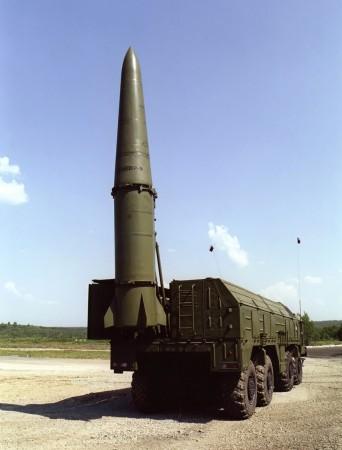
Amidst Russian claims that it is drawing-down from Syria, Israeli spy satellite, Eros B, has revealed high-resolution imagery of Russian nuclear-capable Iskander ballistic missiles in the Hmeymin base in Latakia, Syria.
READ: Super weapons: Russia's electromagnetic railgun should have its enemies very worried
The images were posted on the website of the ImageSat International (iSi), which is a subsidiary of state-owned Israel Aerospace Industries (IAI). IAI builds Israeli spy satellites.
Intelligence analysts from the company say that the image possibly showed two Iskander-launching vehicles (NATO reporting name: SS-26).
The website has an image that shows six different "missile elements under camouflage nets" on November 26.
However probably due to "heavy rain and floods" the two elements were re-deployed to a new location nearby. This is where the two vehicles which the website says is "most probably a part of the Iskandar system exposed".
Defence News notes that way back in March 2016, a Russian military website had shown a video grab of an Iskander launch vehicle at Hmeymim base in Latakia, pointing to the missile system's presence.
One Israeli media website has said that the images are reminiscent of the Cuban missile crisis, when an American U-2 plane took pictures of the missiles headed towards US territory.
What are Iskander missiles?

Iskander missiles are reported to be the missile that NATO fears most. The missiles are short-range ballistic missiles with a range 500km. It can carry a payload of 700kg.
This tactical missile system, according to reports, was designed for theatre-level conflicts. It has the ability to carry both conventional and nuclear warheads. It can engage small and area targets that are moving and stationary. The missile is also said to have stealth technology. The system can also launch cruise missiles. The system includes five ballistic and one cruise missile.
The missiles are said to be able to carry a 50 kiloton nuclear warhead (the Hiroskima A-bomb was 15 kilotons).
Iskander missile deployment

Russia, in November 2016, said it was forced to deploy the Iskander and S-400 missile systems to the Kaliningrad exclave due to the threat posed by US cruise missiles and was in response to US deployment of anti-ballistic systems in Eastern Europe.
The US has opposed the deployment and has called it "unnecessary and destabilising to European security".
Russia in Syria

Russia seems to be using the Middle East as a testing ground for some of its most modern military hardware. After promising to bolster the beleaguered Syrian President Bashir Assad, Russia followed through by sending in its armed forces.
Russia launched bombing campaign in Syria in September 2015, and has turned the civil war in favour of Assad. Assad's forces were able to win the long drawn Aleppo siege.
Russia has announced it will be reducing its deployment in Syria, following a ceasefire pact that was brokered by Turkey and Russia.
It is estimated that only 23 Russian soldiers were killed in the Syrian conflict, it lost five helicopters and three warplanes.
Russia and Israel
Israel is known to have nuclear weapons though it has not officially admitted it. Though the US's is Israel's biggest supporter, Moscow has said that its relations with Israel was special and was based on "friendship, mutual understanding and the long common history".

















